#water science
Text
As relentless rains pounded LA, the city’s “sponge” infrastructure helped gather 8.6 billion gallons of water—enough to sustain over 100,000 households for a year.
Earlier this month, the future fell on Los Angeles. A long band of moisture in the sky, known as an atmospheric river, dumped 9 inches of rain on the city over three days—over half of what the city typically gets in a year. It’s the kind of extreme rainfall that’ll get ever more extreme as the planet warms.
The city’s water managers, though, were ready and waiting. Like other urban areas around the world, in recent years LA has been transforming into a “sponge city,” replacing impermeable surfaces, like concrete, with permeable ones, like dirt and plants. It has also built out “spreading grounds,” where water accumulates and soaks into the earth.
With traditional dams and all that newfangled spongy infrastructure, between February 4 and 7 the metropolis captured 8.6 billion gallons of stormwater, enough to provide water to 106,000 households for a year. For the rainy season in total, LA has accumulated 14.7 billion gallons.
Long reliant on snowmelt and river water piped in from afar, LA is on a quest to produce as much water as it can locally. “There's going to be a lot more rain and a lot less snow, which is going to alter the way we capture snowmelt and the aqueduct water,” says Art Castro, manager of watershed management at the Los Angeles Department of Water and Power. “Dams and spreading grounds are the workhorses of local stormwater capture for either flood protection or water supply.”
Centuries of urban-planning dogma dictates using gutters, sewers, and other infrastructure to funnel rainwater out of a metropolis as quickly as possible to prevent flooding. Given the increasingly catastrophic urban flooding seen around the world, though, that clearly isn’t working anymore, so now planners are finding clever ways to capture stormwater, treating it as an asset instead of a liability. “The problem of urban hydrology is caused by a thousand small cuts,” says Michael Kiparsky, director of the Wheeler Water Institute at UC Berkeley. “No one driveway or roof in and of itself causes massive alteration of the hydrologic cycle. But combine millions of them in one area and it does. Maybe we can solve that problem with a thousand Band-Aids.”
Or in this case, sponges. The trick to making a city more absorbent is to add more gardens and other green spaces that allow water to percolate into underlying aquifers—porous subterranean materials that can hold water—which a city can then draw from in times of need. Engineers are also greening up medians and roadside areas to soak up the water that’d normally rush off streets, into sewers, and eventually out to sea...
To exploit all that free water falling from the sky, the LADWP has carved out big patches of brown in the concrete jungle. Stormwater is piped into these spreading grounds and accumulates in dirt basins. That allows it to slowly soak into the underlying aquifer, which acts as a sort of natural underground tank that can hold 28 billion gallons of water.
During a storm, the city is also gathering water in dams, some of which it diverts into the spreading grounds. “After the storm comes by, and it's a bright sunny day, you’ll still see water being released into a channel and diverted into the spreading grounds,” says Castro. That way, water moves from a reservoir where it’s exposed to sunlight and evaporation, into an aquifer where it’s banked safely underground.
On a smaller scale, LADWP has been experimenting with turning parks into mini spreading grounds, diverting stormwater there to soak into subterranean cisterns or chambers. It’s also deploying green spaces along roadways, which have the additional benefit of mitigating flooding in a neighborhood: The less concrete and the more dirt and plants, the more the built environment can soak up stormwater like the actual environment naturally does.
As an added benefit, deploying more of these green spaces, along with urban gardens, improves the mental health of residents. Plants here also “sweat,” cooling the area and beating back the urban heat island effect—the tendency for concrete to absorb solar energy and slowly release it at night. By reducing summer temperatures, you improve the physical health of residents. “The more trees, the more shade, the less heat island effect,” says Castro. “Sometimes when it’s 90 degrees in the middle of summer, it could get up to 110 underneath a bus stop.”
LA’s far from alone in going spongy. Pittsburgh is also deploying more rain gardens, and where they absolutely must have a hard surface—sidewalks, parking lots, etc.—they’re using special concrete bricks that allow water to seep through. And a growing number of municipalities are scrutinizing properties and charging owners fees if they have excessive impermeable surfaces like pavement, thus incentivizing the switch to permeable surfaces like plots of native plants or urban gardens for producing more food locally.
So the old way of stormwater management isn’t just increasingly dangerous and ineffective as the planet warms and storms get more intense—it stands in the way of a more beautiful, less sweltering, more sustainable urban landscape. LA, of all places, is showing the world there’s a better way.
-via Wired, February 19, 2024
#california#los angeles#water#rainfall#extreme weather#rain#atmospheric science#meteorology#infrastructure#green infrastructure#climate change#climate action#climate resilient#climate emergency#urban#urban landscape#flooding#flood warning#natural disasters#environmental news#climate news#good news#hope#solarpunk#hopepunk#ecopunk#sustainability#urban planning#city planning#urbanism
13K notes
·
View notes
Text

0 notes
Text
Unraveling the Mysteries of Water: Pressure, Flow, and Everything In Between
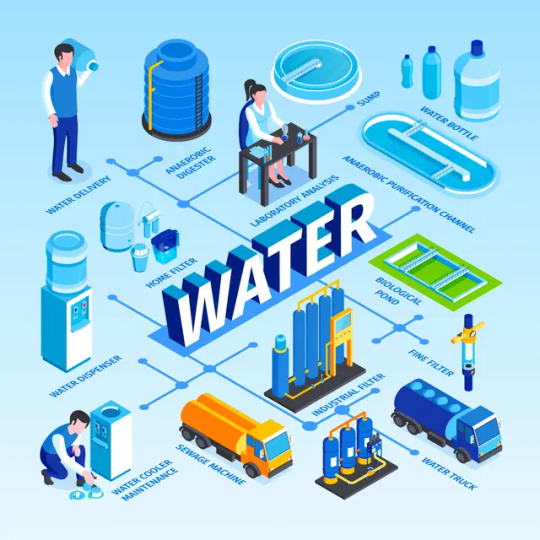
Have you ever turned on the tap, and instead of a steady gush, you get a pathetic trickle? Or maybe you’ve always wondered why sometimes the hose in the garden feels like it could knock you over, while other times it feels like a gentle summer drizzle? Well, the forces at play here are water pressure and flow.
If you've ever been curious about how they work, this post is perfect for you. Let's dive in, no pun intended, and break this down. Shall we?
Basics of Water Pressure: The Invisible Push
Water pressure is like that invisible hand that makes sure water gets from one place to another. Imagine you're blowing up a balloon. The harder you blow, the more the air pushes on the inside of the balloon, and the bigger it becomes. This push is similar to water pressure.
Now, a key player in understanding water pressure is, you guessed it, a water flow device. Such devices help measure and control how water moves. You'll find that in some places, the pressure is high because of how the water system is set up. For instance, water towers use gravity to create water pressure, making sure our homes have a steady supply.
It's important to remember that the actual flow of water isn't the pressure. The pressure is the force that drives the water. In the next point, we’ll clarify that.
Water Flow: It's All About the Move
Okay, so if water pressure is the push, then water flow is the dance! It's the actual movement of water. Think of it like this: you've got a big crowd (the water) at a concert, and the music starts. Everyone starts moving and grooving. That's your water flow.
Again, our trusty water flow device comes into play. It helps monitor and manage how swiftly or slowly that crowd is dancing. If you want a stronger flow in your shower, for example, you'll need both good water pressure to give the push and a water flow device to ensure that the water can move smoothly without any hiccups.
The relationship between pressure and flow is a delicate balance. Too much pressure and not enough flow? You've got problems. The reverse? Still problems.
The Role of the Water Flow Device
So, we've mentioned the water flow device a few times now. But what exactly is it? Well, as you've probably guessed, it's a tool that's designed to help control, measure, and manage how water flows.
In our homes, we have several water flow devices. Faucets, for example, can be considered a basic type. By turning the tap, we're adjusting a water flow device to increase or decrease the flow. More complex devices can be found in water management systems, ensuring that towns and cities have just the right amount of water flowing through them.
Thanks to these devices, we can enjoy consistent showers, fill our pools without overflowing, and water our gardens just right.
Why Pressure and Flow Matter in Daily Life
At first glance, you might think, "Why does it matter so much?" But understanding water pressure and flow is akin to understanding the rhythm of our daily lives. These elements touch upon nearly every aspect of our routine.
Imagine making your morning coffee with a trickle from your kitchen tap. It could mean waiting minutes instead of seconds to fill your pot. This not only affects your routine but also how you perceive the start of your day.
Additionally, let's talk about chores. When washing dishes or doing laundry, the right water flow ensures efficiency. With the correct pressure, your dishwasher functions optimally, ensuring clean dishes every time.
Lastly, consider the leisure and relaxation aspects. A warm bath after a long day can feel therapeutic. But if the flow is too slow, the bath might turn cold before it's full. Thanks to a consistent balance of water pressure and flow (often maintained using a water flow device), you can enjoy these little luxuries without hassle. For more details visit us at https://www.nemfg.com/.
Common Issues with Water Pressure and Flow
While we often take consistent water pressure and flow for granted, there can be moments when things don't run smoothly. Being aware of common issues can help us troubleshoot faster.
Sometimes, old plumbing systems can be the culprit. Rust, sediment buildup, or even mineral deposits can reduce the diameter of pipes, affecting flow. Imagine trying to run through a narrow alley compared to an open field.
Then, there's the problem of shared pipelines, especially in apartments or densely populated areas. If everyone decides to take a shower at the same time, you might notice a drop in your water pressure.
External factors also play a role. Seasonal changes, particularly in colder regions, can cause water to freeze in the pipes, affecting both pressure and flow. It's always a good idea to have some insulation around your pipes if you live in such areas.
Lastly, sometimes, the water flow device itself can malfunction, leading to inconsistent flow. Regular checks and maintenance can prevent or resolve such issues.
Tips and Tricks to Optimize Water Pressure and Flow
To ensure that you always have a consistent and optimal water experience, there are several steps you can take. Prevention, they say, is better than cure!
One simple trick is to schedule high water usage activities during off-peak times. For instance, if you live in an apartment, consider showering at times when it's less likely for others to do the same. This ensures you get the best pressure available.
Regularly inspecting your home's plumbing system can also help. Look out for visible leaks, rusted pipes, or any damage. Sometimes, the issue can be as minor as a washer in a faucet that needs replacing.
Water softeners can be a boon for homes in areas with hard water. They help prevent mineral buildup in your pipes, ensuring smoother water flow.
Furthermore, consider investing in adjustable water flow devices. They allow you to tweak and find a flow rate that's perfect for your needs.
Lastly, always be conscious of your water usage habits. For instance, ensure taps are closed properly and don’t leave the hose running unnecessarily. A combination of mindfulness and regular maintenance ensures a perfect water balance in your home.
Conclusion
The dance between water pressure and flow is an essential aspect of our daily lives, from that morning cup of coffee to that late-night bath. While issues might arise occasionally, with the right tips, tricks, and a keen eye on our water flow device, we can ensure smooth flow.
So, the next time you revel in a perfect shower or admire your garden being watered just right, give a nod to the science and a bit of care that made it possible.
Read More:
Driving Precision: The Role of Pressure Gauge Calibration Services in Digital Tire Monitoring
Pitot Tubes Uncovered: Mastering the Mechanics of Water Flow
The Interplay of the Pitot Tube Flow Meter with Static Pressure: A Closer Look
#Water flow device#Flow Dynamics#Water Science#Device Insights#Water Research#Flow Measurement#Pressure Analysis
0 notes
Text
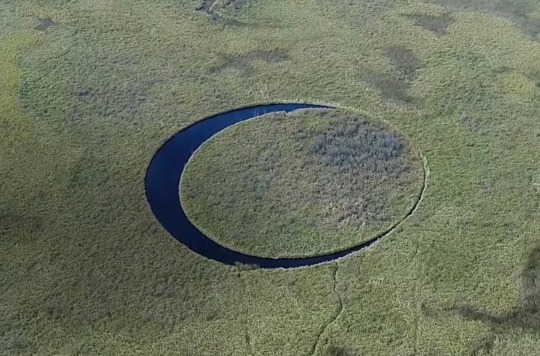

El Ojo ‘The Eye’ Island Location: Buenos Aires, Argentina
First discovered by Argentinian filmmaker Sergio Neuspiller in 2003, El Ojo is an uninhabited circular rotating floating island located within a slightly larger circular lake in the Paraná Delta in the Buenos Aires Province, Argentina. This island is constantly rotating on its own axis due to the flow of the river beneath it. The island was named because of its resemblance to an eye when viewed from above: as the island rotates within its surrounding circular lake, the eye appears to move.
#buenos aires#argentina#water#physics#planet#planet earth#nature#science#sciencecore#interesting#aesthetic#earth#eye#eyecore#weirdcore#weird#phenomenon#weird phenomenons#strange#places#google earth#weird places#weird stuff#watercore#lakes#lake#water aesthetic#nature aesthetic#geography#illusions
6K notes
·
View notes
Text

A rare moment during the process of coral bleaching
9K notes
·
View notes
Text
NASA Inspires Your Crafty Creations for World Embroidery Day
It’s amazing what you can do with a little needle and thread! For #WorldEmbroideryDay, we asked what NASA imagery inspired you. You responded with a variety of embroidered creations, highlighting our different areas of study.
Here’s what we found:
Webb’s Carina Nebula
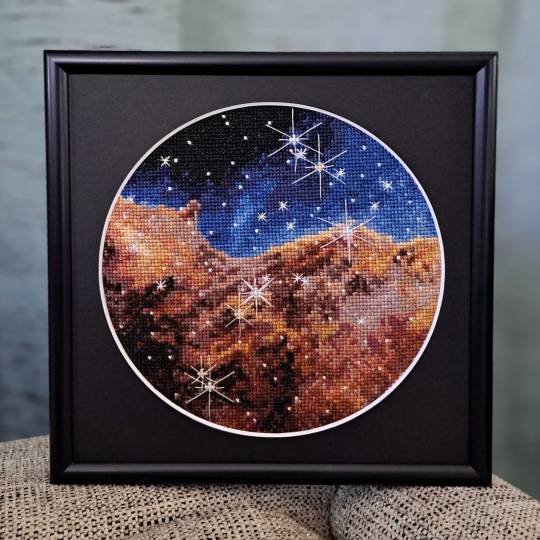
Wendy Edwards, a project coordinator with Earth Science Data Systems at NASA, created this embroidered piece inspired by Webb’s Carina Nebula image. Captured in infrared light, this image revealed for the first time previously invisible areas of star birth. Credit: Wendy Edwards, NASA. Pattern credit: Clare Bray, Climbing Goat Designs
Wendy Edwards, a project coordinator with Earth Science Data Systems at NASA, first learned cross stitch in middle school where she had to pick rotating electives and cross stitch/embroidery was one of the options. “When I look up to the stars and think about how incredibly, incomprehensibly big it is out there in the universe, I’m reminded that the universe isn’t ‘out there’ at all. We’re in it,” she said. Her latest piece focused on Webb’s image release of the Carina Nebula. The image showcased the telescope’s ability to peer through cosmic dust, shedding new light on how stars form.
Ocean Color Imagery: Exploring the North Caspian Sea
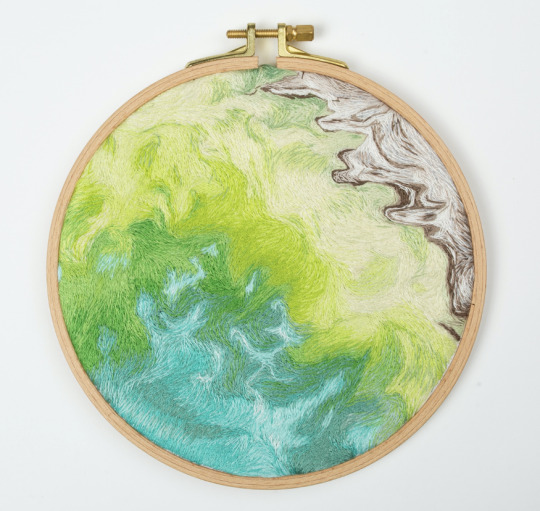
Danielle Currie of Satellite Stitches created a piece inspired by the Caspian Sea, taken by NASA’s ocean color satellites. Credit: Danielle Currie/Satellite Stitches
Danielle Currie is an environmental professional who resides in New Brunswick, Canada. She began embroidering at the beginning of the Covid-19 pandemic as a hobby to take her mind off the stress of the unknown. Danielle’s piece is titled “46.69, 50.43,” named after the coordinates of the area of the northern Caspian Sea captured by LandSat8 in 2019.

An image of the Caspian Sea captured by Landsat 8 in 2019. Credit: NASA
Two Hubble Images of the Pillars of Creation, 1995 and 2015
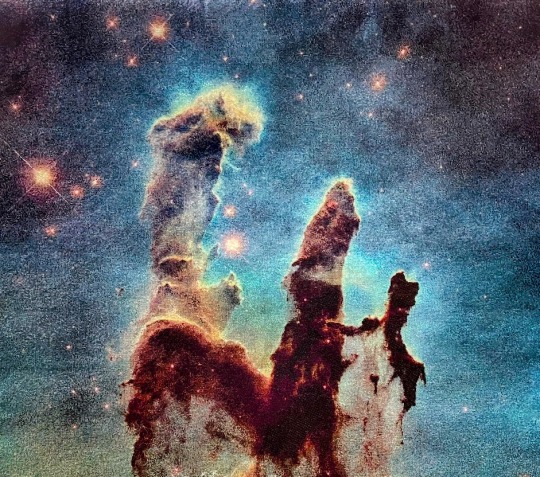
Melissa Cole of Star Stuff Stitching created an embroidery piece based on the Hubble image Pillars of Creation released in 1995. Credit: Melissa Cole, Star Stuff Stitching
Melissa Cole is an award-winning fiber artist from Philadelphia, PA, USA, inspired by the beauty and vastness of the universe. They began creating their own cross stitch patterns at 14, while living with their grandparents in rural Michigan, using colored pencils and graph paper. The Pillars of Creation (Eagle Nebula, M16), released by the Hubble Telescope in 1995 when Melissa was just 11 years old, captured the imagination of a young person in a rural, religious setting, with limited access to science education.

Lauren Wright Vartanian of the shop Neurons and Nebulas created this piece inspired by the Hubble Space Telescope’s 2015 25th anniversary re-capture of the Pillars of Creation. Credit: Lauren Wright Vartanian, Neurons and Nebulas
Lauren Wright Vartanian of Guelph, Ontario Canada considers herself a huge space nerd. She’s a multidisciplinary artist who took up hand sewing after the birth of her daughter. She’s currently working on the illustrations for a science themed alphabet book, made entirely out of textile art. It is being published by Firefly Books and comes out in the fall of 2024. Lauren said she was enamored by the original Pillars image released by Hubble in 1995. When Hubble released a higher resolution capture in 2015, she fell in love even further! This is her tribute to those well-known images.
James Webb Telescope Captures Pillars of Creation

Darci Lenker of Darci Lenker Art, created a rectangular version of Webb’s Pillars of Creation. Credit: Darci Lenker of Darci Lenker Art
Darci Lenker of Norman, Oklahoma started embroidery in college more than 20 years ago, but mainly only used it as an embellishment for her other fiber works. In 2015, she started a daily embroidery project where she planned to do one one-inch circle of embroidery every day for a year. She did a collection of miniature thread painted galaxies and nebulas for Science Museum Oklahoma in 2019. Lenker said she had previously embroidered the Hubble Telescope’s image of Pillars of Creation and was excited to see the new Webb Telescope image of the same thing. Lenker could not wait to stitch the same piece with bolder, more vivid colors.
Milky Way

Darci Lenker of Darci Lenker Art was inspired by NASA’s imaging of the Milky Way Galaxy. Credit: Darci Lenker
In this piece, Lenker became inspired by the Milky Way Galaxy, which is organized into spiral arms of giant stars that illuminate interstellar gas and dust. The Sun is in a finger called the Orion Spur.
The Cosmic Microwave Background
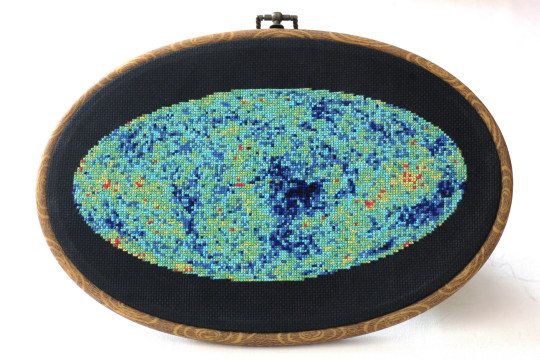
This image shows an embroidery design based on the cosmic microwave background, created by Jessica Campbell, who runs Astrostitches. Inside a tan wooden frame, a colorful oval is stitched onto a black background in shades of blue, green, yellow, and a little bit of red. Credit: Jessica Campbell/ Astrostitches
Jessica Campbell obtained her PhD in astrophysics from the University of Toronto studying interstellar dust and magnetic fields in the Milky Way Galaxy. Jessica promptly taught herself how to cross-stitch in March 2020 and has since enjoyed turning astronomical observations into realistic cross-stitches. Her piece was inspired by the cosmic microwave background, which displays the oldest light in the universe.

The full-sky image of the temperature fluctuations (shown as color differences) in the cosmic microwave background, made from nine years of WMAP observations. These are the seeds of galaxies, from a time when the universe was under 400,000 years old. Credit: NASA/WMAP Science Team
GISSTEMP: NASA’s Yearly Temperature Release

Katy Mersmann, a NASA social media specialist, created this embroidered piece based on NASA’s Goddard Institute for Space Studies (GISS) global annual temperature record. Earth’s average surface temperature in 2020 tied with 2016 as the warmest year on record. Credit: Katy Mersmann, NASA
Katy Mersmann is a social media specialist at NASA’s Goddard Space Flight Center in Greenbelt, Md. She started embroidering when she was in graduate school. Many of her pieces are inspired by her work as a communicator. With climate data in particular, she was inspired by the researchers who are doing the work to understand how the planet is changing. The GISTEMP piece above is based on a data visualization of 2020 global temperature anomalies, still currently tied for the warmest year on record.
In addition to embroidery, NASA continues to inspire art in all forms. Check out other creative takes with Landsat Crafts and the James Webb Space telescope public art gallery.
Make sure to follow us on Tumblr for your regular dose of space!
#NASA#creativity#fiber art#embroidery#art#art challenge#needlework#crafts#handmade#textile art#cross stitch#stitching#inspiration#inspo#Earth#Earth science#Hubble#James Webb Space Telescope#climate change#water#nebula#stars
6K notes
·
View notes
Photo

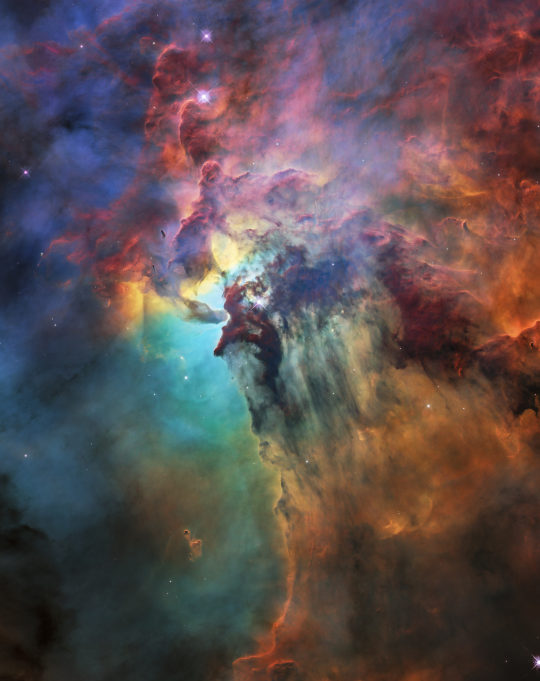

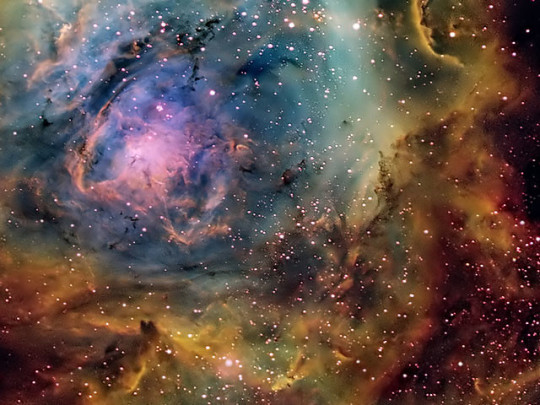


M8, Waters of the Lagoon
#Astronomy#NASA#Night#Sky#Stars#Space#Science#Universe#Cosmos#Cosmic#Solar System#Waters#Nebula#Lagoon#Galaxy#Constellations#Constellation#Rainbow#Bright
5K notes
·
View notes
Text

Have you ever seen the Spectacled Eider (Somateria fischeri)? During breeding season, males sport green plumage in a pattern that's reminiscent of glasses. While this doesn't make their vision sharper, it does help males stand out from the crowd.For the rest of the year, they revert to mottled-brown plumage, similar to females, which have more subdued spectacles year-round. This duck is unique in that it lives in the frigid high Arctic. It sustains itself on a diet of mostly mollusks and crustaceans, diving to pluck prey from the ocean floor.
Photo: Olaf Oliviero Riemer, CC BY-SA 3.0, Wikimedia Commons
#science#nature#natural history#animals#birds#ornithology#ducks#spectacled eider#water fowl#cool animals#did you know#fact of the day#arctic#glasses
1K notes
·
View notes
Text




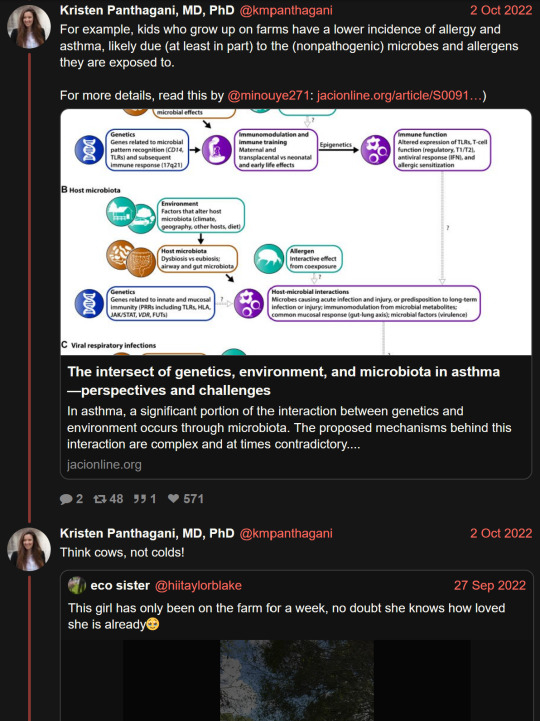


"Do not let anyone convince you that you need to get sick to be healthy."
#kristen panthagani#immunology#sars cov 2#long post#i s2g if i see one more bullshit article/comment about IMmUNiTY deBT........................#for the millionth billionth fucking time: IMMUNITY DEBT ISN'T REAL. there is NO SUCH THING as immunity debt caused by avoiding illness#and ANY dr/immunologist worth their salt in the year 2023 will tell you that#“but you have to train your immune system for it to get stronger!” nope doesn't work like that. the immune system is not a muscle#you might as well tell everyone that the reason they don't have skin like armoured steel is that they haven't been stabbed enough#tell all those drs treating tuberculosis patients that they're weakening their immunity by wearing respirators and NOT catching tb#let's all stop filtering the water while we're at it. have everyone get cholera - that'll fortify ppl's immune systems for sure#this world is a joke.#ppl buy into this shit and then wonder why the anti-vaxx/anti-science movement keeps growing
2K notes
·
View notes
Text

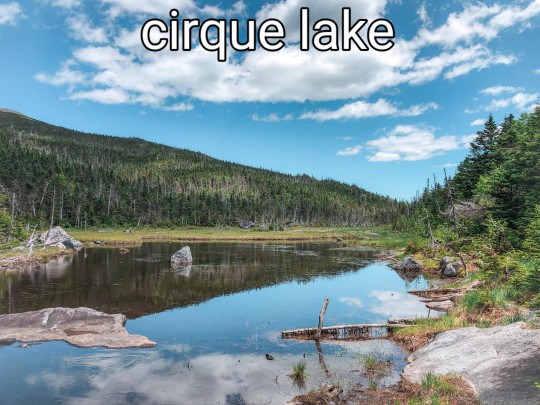
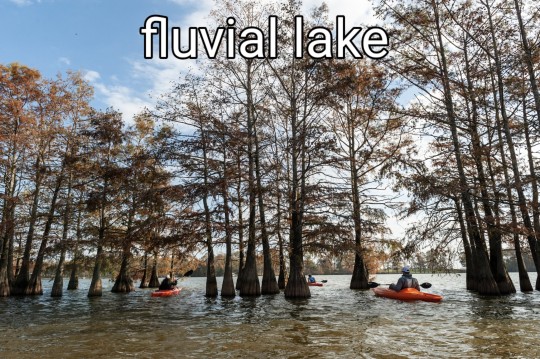

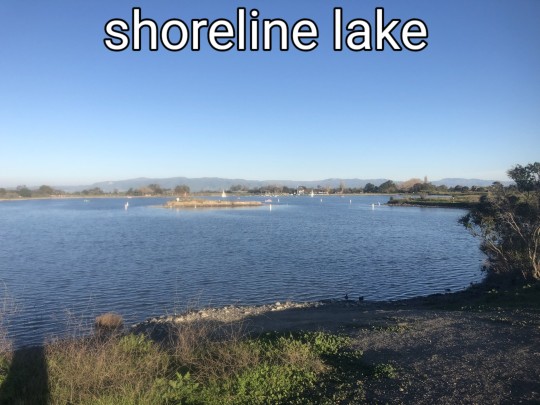
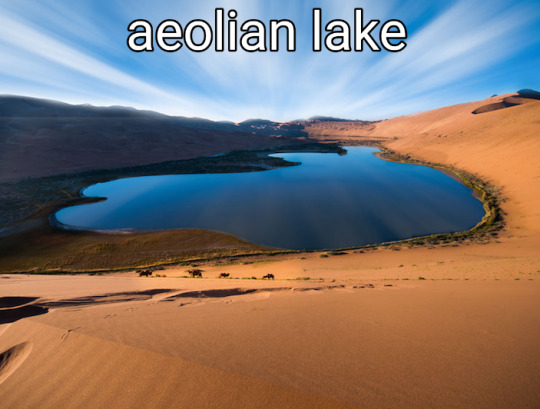




#lakes#lakeposting#poll#geology#geomorphology#nature#lake#naturecore#beautiful#limnology#science#ecology#aquatic ecology#water#meteor#meteorite#volcanic#glacier#glacial#tectonic#earth#environment#environmental science
2K notes
·
View notes
Text
"Namibia is the driest country in Sub-Saharan Africa, and home to two of the world’s most ancient deserts, the Kalahari and the Namib. The capital, Windhoek, is sandwiched between them, 400 miles away from the nearest perennial river and more than 300 miles away from the coast. Water is in short supply.
It’s hard to imagine life thriving in Windhoek, yet 477,000 people call it home, and 99 per cent of them have access to drinking water thanks to technology pioneered 55 years ago on the outskirts of the city. Now, some of the world’s biggest cities are embracing this technology as they adapt to the harshest impacts of climate change. But Namibia leads the way.
How did this come about? In the 1950s, Windhoek’s natural resources struggled to cope with a rapidly growing population, and severe water shortages gripped the city. But disaster forced innovation, and in 1968 the Goreangab Water Reclamation Plant in Windhoek became the first place in the world to produce drinking water directly from sewage, a process known as direct potable reuse (DPR).
That may sound revolting, but it’s completely safe. Dr Lucas van Vuuren, who was among those who pioneered Windhoek’s reclamation system, once said that “water should not be judged by its history, but by its quality”. And DPR ensures quality.
This is done using a continuous multi-barrier treatment devised in Windhoek during eight years of pilot studies in the 1960s. This process – which has been upgraded four times since 1968 – eliminates pollutants and safeguards against pathogens by harnessing bacteria to digest the human waste and remove it from the water. This partly mimics what happens when water is recycled in nature, but Windhoek does it all in under 24 hours...
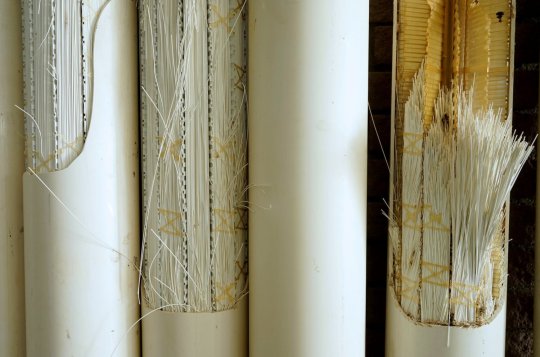
Pictured: These ultrafiltration membranes help to remove bacteria, viruses and pathogens. Image: Margaret Courtney-Clarke
“We know that we have antibiotics in the water, preservatives from cosmetics, anti-corrosion prevention chemicals from the dishwasher,” Honer explains. “We find them and we remove them.”
Honer adds that online instruments monitor the water continuously, and staff ensure that only drinking water that meets World Health Organisation (WHO) guidelines is sent to homes. If any inconsistencies are detected, the plant goes into recycle mode and distribution is halted until correct values are restored.
“The most important rule is, and was, and always will be ‘safety first’,” says Honer. The facility has never been linked to an outbreak of waterborne disease, and now produces up to 5.5m gallons of drinking water every day – up to 35 per cent of the city’s consumption.
Namibians couldn’t survive without it, and as water shortages grip the planet, Windhoek’s insights and experience are more important than ever.
Interest from superpowers across the globe
In recent years, delegations from the US, France, Germany, India, Australia, Singapore, and the United Arab Emirates have visited Windhoek seeking solutions to water shortages in their own countries.
Megadrought conditions have gripped the US since 2001, and the Colorado River – which provides 40 million people with drinking water – has been running at just 50 per cent of its traditional flow. As a result, several states including Texas, California, Arizona and Colorado are beginning to embrace DPR.
Troy Walker is a water reuse practice leader at Hazen and Sawyer, an environmental engineering firm helping Arizona to develop its DPR regulations. He visited Windhoek last year. “It was about being able to see the success of their system, and then looking at some of the technical details and how that might look in a US facility or an Australian facility,” he said. “[Windhoek] has helped drive a lot of discussion in industry. [Innovation] doesn’t all have to come out of California or Texas.”

Pictured: The internal pipes and workings of Namibia's DPR plant. As water becomes scarcer in some parts, countries are looking to DPR for solutions. Image: Margaret Courtney-Clarke
Namibia has also helped overcome the biggest obstacle to DPR – public acceptance. Disgust is a powerful emotion, and sensationalist ‘toilet to tap’ headlines have dismantled support for water reuse projects in the past. Unfortunately, DPR’s biggest strength is also its biggest weakness, as the speed at which water can re-enter the system makes it especially vulnerable to prejudice, causing regulators to hesitate. “Technology has never been the reason why these projects don’t get built – it’s always public or political opposition,” says Patsy Tennyson, vice president of Katz and Associates, an American firm that specialises in public outreach and communications.
That’s why just a handful of facilities worldwide are currently doing DPR, with Windhoek standing alongside smaller schemes in the Philippines, South Africa and a hybrid facility in Big Spring, Texas. But that’s all changing. Drought and increased water scarcity worldwide are forcing us to change the way we think about water.
Now, the US is ready to take the plunge, and in 2025, El Paso Water will begin operating the first ‘direct to distribution’ DPR facility in North America, turning up to 10m gallons of wasterwater per day into purified drinking water – twice as much as Windhoek. San Diego, Los Angeles, California, as well as Phoenix, Arizona are also exploring the technology."
Of course, DPR is not a silver bullet in the fight against climate change. It cannot create water out of thin air, and it will not facilitate endless growth. But it does help cities become more climate resilient by reducing their reliance on natural sources, such as the Colorado River.
As other nations follow in Namibia’s footsteps, Windhoek may no longer take the lead after almost six decades in front.
“But Windhoek was the first,” Honer reminds me. “No one can take that away.”"
-via Positive.News, August 30, 2023
#namibia#africa#desert#water shortage#water conservation#dpr#potable water#water recycling#clean water#drought#united states#colorado river#science and technology#sanitation#good news#hope
2K notes
·
View notes
Text

Always Waiting
~☆◇Prints◇☆~▪︎~☆◇Commissions◇☆~▪︎~☆◇Kofi◇☆~▪︎~☆◇For inquiries: [email protected]◇☆~
#ichi makes art#art#digital art#illustration#fantasy art#digital illustration#science fiction#scifi#landscapes#cat#robots#sculptures#body horror#water#plants#nature#2d animation#animated#gif warning
521 notes
·
View notes
Text
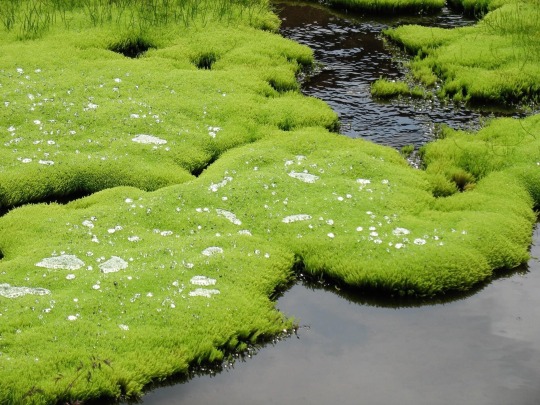
#winter#mosscore#water#grass#green#green photography#green aesthetic#photography#photoblog#color#nature#outdoors#nature travel#landscape#colors#science#river#beach
806 notes
·
View notes
Text

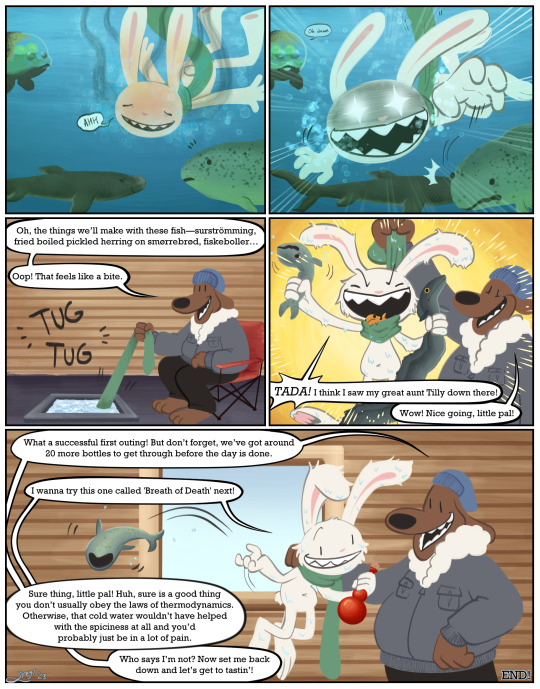
BEHOLD!! I made an entry to Skunkape's 2023 Holiday Contest! :'Dc I worked so fuckin hard on it hhhrhrhrhgdhsjglshgjdjfh and let me tell you, I do not at all hope to win but I do hope it makes Steve snicker. Just the thought that he'll be seeing it is wild. Hope it makes y'all snicker too ehehehe!!
#piscatological: having to do with the science or study of fishing#and yeah I did look up a complicated word on purpose hehe >:3 I think that’s what Sam does in his spare time anyway#fun fact I was gonna give Sam a blue coat but then I realized that he bore a striking and unnerving resemblance to one Sans Undertale#so that had to get scrapped lmaooooo#but I really like how it turned out anyway heheheheeeee#I really liked making Sam dream of terrible fish dishes jdklgjdlsghdsf (terrible by the definition of a list I found somewhere lmao)#all I know about surströmming is that is is so smelly you have to open it outdoors in a bucket of water apparently#terrible. they’d love it though sskskshgfjfhdjdgs#sam and max#sam and max freelance police#freelance husbands#my art#skunkape holiday contest
851 notes
·
View notes
Text
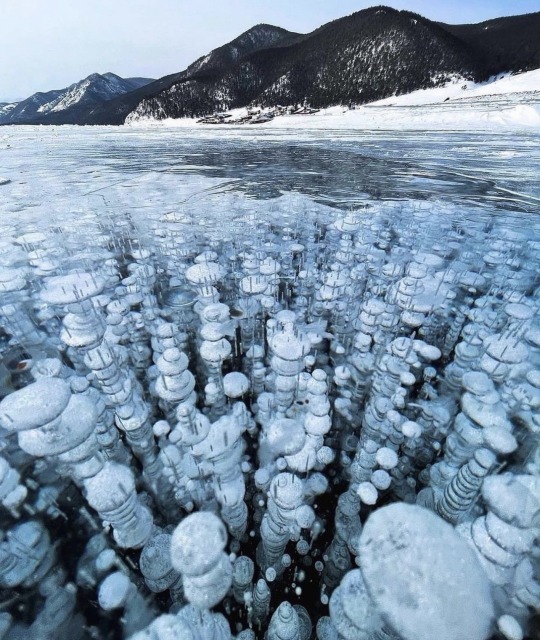

Underwater Ice Bubbles
This phenomenon takes place as decomposing plants on the bottom of lakes emit methane gas and form bubbles while the lake begins to freeze.
3K notes
·
View notes
